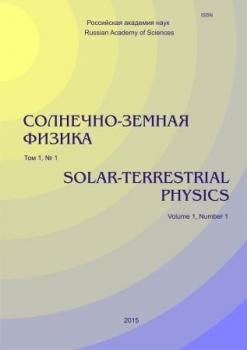с 01.01.2011 по настоящее время
Якутск, Республика Саха (Якутия), Россия
Якутск, Россия
Якутск, Россия
Якутск, Россия
Представлена температурная база данных для области мезопаузы, полученная по спектральным измерениям полос (0-1) Атмосферной системы О2(0-1) и ОН(6-2) с помощью спектрографа СП-50 на станции Маймага (63° N, 129.5° E) в течение 2002–2014 гг. Временной ряд температуры включает в себя 11-летний солнечный цикл. Проведено ее сравнение с температурой, полученной радиометром SABER (версии данных v.1.07 и v.2.0), расположенным на спутнике TIMED. Сравнивались температуры, измеренные при пролетах спутника не далее 500 км от точки пересечения линии визирования спектрографа с излучающими слоями гидроксила (~87 км) и кислорода (~95 км). Временной критерий составляет 30 минут. Установлено, что наблюдается сезонная зависимость разности между данными измерений наземным прибором и со спутника. Данные, полученные при помощи SABER v2.0 показали хорошее согласие с температурами, измеренными инфракрасным цифровым спектрографом. На основании проведенного анализа сделан вывод, что ряды вращательных температур, полученных на станции Маймага, могут быть использованы для исследования колебаний температуры различных временных масштабов, в том числе и долговременных трендов на высоте мезопаузы.
излучение OH и O2, температура мезопаузы, SABER/TIMED
INTRODUCTION
At present, the comparison between ground and satellite measurements is of topical interest. It is necessary to evaluate possible differences between them for a long period. We compare OH(6-2) and O2(0-1) rotational temperatures measured during 2002–2014 (the Maimaga high-latitude station (63° N; 129.5° E) infrared spectrograph) with mesopause kinetic temperatures at ~87 and ~95 km heights measured with the Sounding of the Atmosphere using Broadband Emission Radiometry (SABER) instrument onboard NASA’s TIMED (Thermosphere, Ionosphere, Mesosphere Energetics and Dynamics) spacecraft [Mertens et al., 2001]. Many studies on the comparison between SABER temperatures and those measured with ground-based techniques and instruments have been published in recent years [Remsberg et al., 2008; Smith et al., 2010; French, Mulligan, 2010; Gavrilyeva et al., 2011]. They give an estimate of the offset or bias between data from SABER and ground-based instruments. All of these studies involve relatively short data runs [French and Mulligan, 2010]. We use ground-based data on OH(6-2) and O2(0-1) rotational temperatures for 2002–2014, which allow us to examine biases between SABER and Maimaga data obtained over this period.
1. Baker D.J., Stair A.T. Rocket measurements of the altitude distribution of the hydroxyl airglow. Physica Scripta. 1988, vol. 37, no. 4, pp. 611-622.
2. French W.J.R., Mulligan F.J. Stability of temperatures from TIMED/SABER v1.07 (2002-2009) and Aura/MLS v2.2 (2004-2009) compared with OH(6-2) temperatures observed at Davis Station, Antarctica. Atmos. Chem. Phys. 2010, vol. 10, pp. 11439-11446. DOI:https://doi.org/10.5194/acp-10-11439-2010.
3. Gavrilyeva G.A., Ammosov P.P. Near-mesopause temperatures registered over Yakutia. J. Atmos. Solar Terr. Phys. 2002, vol. 64, pp. 985-990.
4. Gavrilyeva, G.A., Ammosov P.P., Koltovskoi I.I. Compari-son of ground-based and satellite measurements of atmospheric temperature in the mesopause region in high-latitude Eastern Siberia. Geomagnetism and Aeronomy. 2011, vol. 51, pp. 557-563.
5. Krassovsky V.I., Shefov N.N., Yarin V.I. Atlas of the airglow spectrum 3000-12400 Å. Planet Space Sci. 1962, vol. 9. no. 12, pp. 883-915.
6. Kutepov A.A., Feofilov A.G., Marshall B.T., Gordley L.L., Pesnel W.D., Goldberg R.A., Russell III J.M. SABER temperature observations in the summer polar mesosphere and lower thermosphere: Importance of accounting for the CO2 ν2 quanta V-V exchange. Geophys. Res. Lett. 2006, vol. 33, pp. L21809. DOI:https://doi.org/10.1029/2006GL026591.
7. Mertens C.J., Mlynczak M.G., López-Puertas M., Wintersteiner P.P., Picard R.H., Winick J.R., Gordley L.L., Russell III J.M. Retrieval of mesospheric and lower thermospheric kinetic temperature from measurements of CO2 15 µ Earth limb emission under non-LTE conditions. Geophys. Res. Lett. 2001, vol. 28, pp. 1391-1394.
8. Mies F.H. Calculated vibrational transition probabilities of OH(X2Π). J. Molecular Spectroscopy. 1974, vol. 53, no. 2, pp. 150-188.
9. Remsberg E.E., Marshall B.T., Garcia-Comas M., Krueger D. Lingenfelser G.S., Martin-Torres J., Mlynczak M.G., Russell J.M., Smith A.K., Zhao Y., Brown C., Gordley L.L., Lopez-Gonzalez M.J., Lopez-Puertas M., She C.-Y., Taylor M.J., Thompson R.E. Assessment of the quality of the version 1.07 temperature-versus-pressure profiles of the middle atmosphere from TIMED/SABER. J. Geophys. Res.-Atmos. 2008, vol. 113, pp. D17101. DOI:https://doi.org/10.1029/2008jd010013.
10. Smith A.K, Marsh D.R, Mlynczak M.G., Mast J.C. Temporal variations of atomic oxygen in the upper mesosphere from SABER. J. Geophys. Res. 2010, vol. 115, pp. D18309. DOI:https://doi.org/10.1029/2009JD013434.
11. Winick J., Wintersteiner P.P., Picard R.H., Esplin D., Mlynczak M.G., Russell III J.M., Gordley L.L. OH layer characteristics during unusual boreal winters of 2004 and 2006. J. Geophys. Res. 2009, vol. 114, pp. A02303. DOI: 10.1029/ 2008JA013688.
12. Yee J.H., Crowley G., Roble R.G., Skinner W.R., Burrage M.D., Hays P.B. Global simulations and observations of O(1S), O2(1Σ) and OH mesospheric nightglow emissions. J. Geophys. Res. 1997, vol. 102, no. A9, pp. 19949-19968.


















